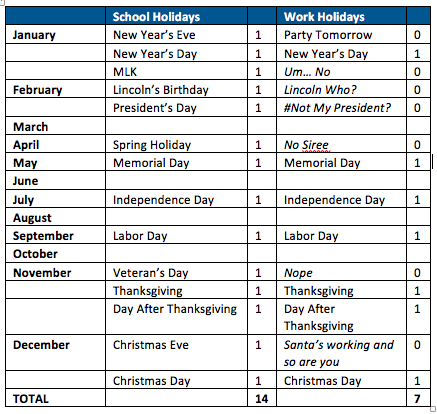It’s February. That time of the year when your school-aged children enjoy a veritable month of three-day weekends. Fun fact: October is the only month with zero days off or minimum days. All the other months in the district calendar enjoy cryptic ellipses, rhombuses, rectangles, and triangles to signify the same thing: no school.
I’ve been meaning to do a little math, and here’s what I’ve found. There are:
365 days in a year
180 school days
104 weekend days
51 days of summer vacation
27 days of school year vacation
12 minimum days and
2 teacher workdays
So that’s 29 full days off of school, not including summer break. Meanwhile, back at the office we have…
20 days of accrued paid time off over the course of the year
7 holidays and
3 days of paid sick leave
For a total of 27 days off of work, or 30 if we’re assuming sick days are not meant for being sick.
Something’s not adding up here….
Let’s look at this math problem using another strategy (we’ve found multiple strategies are the key to extra credit at second grade math homework around our family coffee table).
Beyond summer break we have:
1 week off for Thanksgiving
2 weeks off for Christmas and
1 week off for Spring Break
Totals 4 weeks, which roughly aligns with the accrued time off above.
And if we compare the holidays side-by-side we’ve got:
 The YMCA and SLO Parks and Rec need time to gird themselves for the summer and decompress once those 51 days of summer vacation are over. Some additional fun facts include an entire city without full-time day care or camp the first week after school gets out for the summer, as well as the full week before school starts in August. Plus they generally don’t work school holidays.
The YMCA and SLO Parks and Rec need time to gird themselves for the summer and decompress once those 51 days of summer vacation are over. Some additional fun facts include an entire city without full-time day care or camp the first week after school gets out for the summer, as well as the full week before school starts in August. Plus they generally don’t work school holidays.
I’m not sure I’m ever going to catch-on to this new math.



